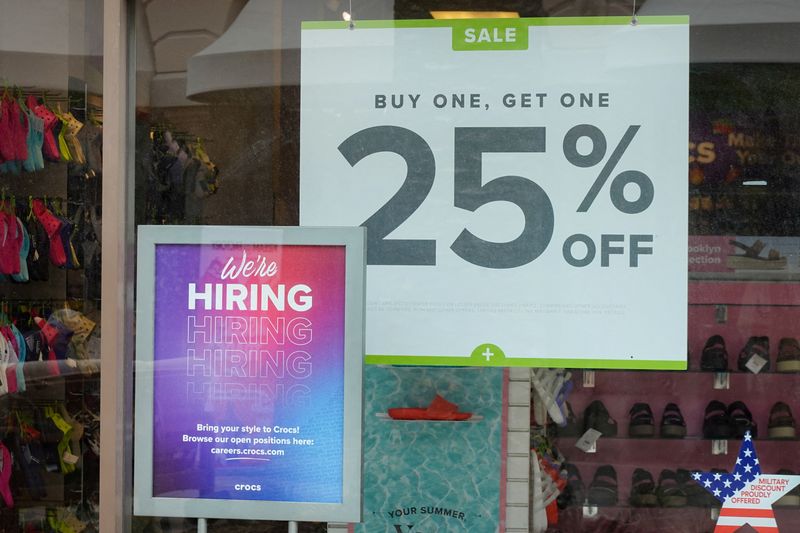Morning Bid: Payrolls, Williams and Waller - a big decider
(Reuters) - A look at the day ahead in U.S. and global markets from Mike Dolan
Friday looks set to play out like a concentrated version of what markets have been navigating all year - what's the fine balance for the U.S. economy to both dodge recession and allow interest rates to come down at the same time.
After a torrent of labor market and business updates all week, the August employment report now acts as the decider, setting the tone for both this month's Federal Reserve meeting and the holy grail of a "soft landing" for the economy.
With one exception, advance soundings show a labor market that's indeed slowing. Private sector payroll growth last month came in well below forecast, layoffs are rising and vacancies receding. Only ebbing weekly jobless claims - the most up-to-the-minute readout - suggest otherwise.
For stock markets, a big rise in the unemployment rate or swoon in jobs created would inevitably increase fears of recession ahead, just like it did last month, even though that would also likely shift the dial towards a 50 basis point (bp) cut in Fed rates on Sept. 18.
The recent re-emergence of a negative correlation between stocks and Treasury bonds may well be reinforced, insulating many mixed asset portfolios, such as 60/40 equity/bond formulations.
Nerves in advance have S&P500 stock futures down almost 1% before the bell on Friday as the index heads for its worst week since April. The "fear index", or VIX volatility gauge, nudged back above 22.
Rallying treasuries, however, have seen the two-year yield fall to 3.70% for the first time since May last year. Ten-year yields also fell, leaving the 2-to-10 year yield curve on a knife edge and inverted to the tune of just 1 bp.
The dollar slipped back to late August levels.
If the consensus forecast proves correct of course, it will likely calm the horses.
And for the record, markets expect payroll growth to have picked up a notch to 160,000 last month and the unemployment rate to have fallen back a tenth of percentage point to 4.2%.
The jobless rate has been in focus ever since it triggered the so-called "Sahm rule" last month on the speed at which a rise in rates suggests recession over the year ahead.
Even though the author of the rule - ex-Fed economist Claudia Sahm - downplayed the significance of the trigger this time around, it will remain a red flag unless the rate recedes in August as expected.
As to Fed thinking, futures now price the chance of a 50 bp rate cut this month, as opposed to the baked-in quarter-point point move, as just shy of 50%. But there's a hefty 111 bps of easing seen to the end of year and 230 bps over the next 12 months.
First to react to the employment report will be two of the Fed's big hitters - Fed Board Governor Christopher Waller and New York Fed President John Williams. And then Fed policymakers head to their traditional blackout period before the next meeting.
On Thursday, U.S. Treasury Secretary and former Fed chair Janet Yellen said the U.S. still has a "good healthy labor market" even if the pace of job creation has slowed.
The Fed has already clearly signalled its intent to start easing this month and has publicly shifted its focus away from waning inflation to the state of the jobs market, the second of its two mandates.
With U.S. crude oil prices back below $70 per barrel and down more than 20% year-on-year, inflation pressures are dissipating further.
TECH IN FOCUS
In companies, market anxiety also centres on lofty chipmaker stocks and news overnight continued to be unsettling on that score.
Broadcom (NASDAQ:AVGO ) forecast fourth-quarter revenue slightly below Wall Street expectations on Thursday, hurt by sluggish spending in its broadband segment. Despite a sharp rise in orders for its artificial intelligence chips, its shares fell more than 7% out of hours.
However, Qualcomm (NASDAQ:QCOM ) has explored the possibility of acquiring portions of Intel (NASDAQ:INTC )'s design business to boost the company's product portfolio, according to two sources familiar with the matter.
Next on the horizon for the tech sector is Apple (NASDAQ:AAPL )'s expected release of its latest iPhone as soon as next week, a model expected to include new AI capabilities.
In politics, markets are also bracing for the first televised debate next Tuesday between U.S. Republican candidate Donald Trump and his Democratic rival Vice President Kamala Harris.
Both candidates this week detailed more economic plans, with Harris indicating a lower capital gains tax proposal than the current administration and Trump positing a corporate tax rate as low as 15%.
Around the world, stock markets in Europe and Asia were generally on the backfoot ahead of the payrolls.
A big mover in Europe was Raiffeisen Bank, which fell 7% after a Russian court froze the shares of the lender's Russian unit, which the company had planned to spin off.
Key developments that should provide more direction to U.S. markets later on Friday:
* US August employment report; Canada August employment report
* Federal Reserve Board Governor Christopher Waller and New York Fed President John Williams both speak after the payrolls report
(By Mike Dolan, editing by Sharon Singleton; Этот адрес электронной почты защищён от спам-ботов. У вас должен быть включен JavaScript для просмотра.)
Source: Investing.com
